
|
 |
Can anybody tell me the most likely scenarios for lack of heat in an electric dryer? |
 |
There are many things that can cause a no heat symptom in an electric dryer, here is a list of possible causes in order of likelihood or ease of access.
- An open fuse/breaker in the house fuse panel.
There are 2 fuses or breakers for the dryer, both must be good in order for the dryer to function properly. If one is open, it is possible for the dryer to run but not generate heat. In the case of breakers, try resetting them as sometimes one of the two can open but not physically tip the mechanical lever.
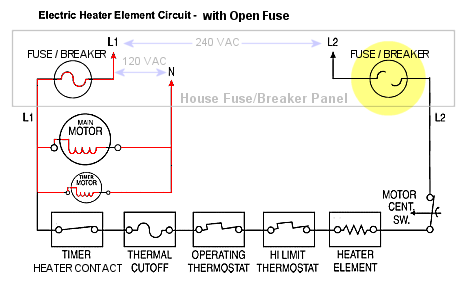
The illustration above shows how the main dryer motor and the timer's motor can continue to operate with one of the two fuses for the dryer open as they operate on 120 volts only. The working circuit could also include a light which is not illustrated.
- An open thermal fuse in the dryer.
Some models use a thermal safety limiter or thermal fuse which could open the circuit to the heat element. These are used to prevent a runaway or over heat condition and are often found mounted to the blower or heater element housing (see the links below for examples). These devices are a fairly current development and may not be found on very old dryers.
 Note: If this is the cause of your current problem (pardon the pun), I strongly suggest you check the vent for obstructions and ensure its length meets the manufacturers recommended limitations, the shorted the better. Failure of this part could be the first indication of a potential fire hazard in the dryer! Note: If this is the cause of your current problem (pardon the pun), I strongly suggest you check the vent for obstructions and ensure its length meets the manufacturers recommended limitations, the shorted the better. Failure of this part could be the first indication of a potential fire hazard in the dryer!
- The element coil is burnt out.
Dryer elements are bare wires coiled like springs, when they fail the wire will break opening the circuit. This breakage could be intermittent, only opening as the element expands as it heats. Sometimes the element coil has to be physically checked for breakages, especially where the coil goes through ceramic insulator which could hide a breakage from plain view.
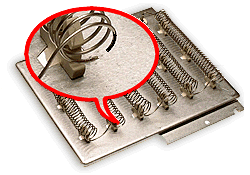 Depending on the brand and style, the replacement element may be just the coiled wire that has to be mounted into the original element housing. On other models the element assembly comes already mounted on a frame that then in installed into the element housing or directly into the dryer. Whichever the case, the element coil has to be replaced not just joined together using connectors.
Depending on the brand and style, the replacement element may be just the coiled wire that has to be mounted into the original element housing. On other models the element assembly comes already mounted on a frame that then in installed into the element housing or directly into the dryer. Whichever the case, the element coil has to be replaced not just joined together using connectors.
- Open switches.
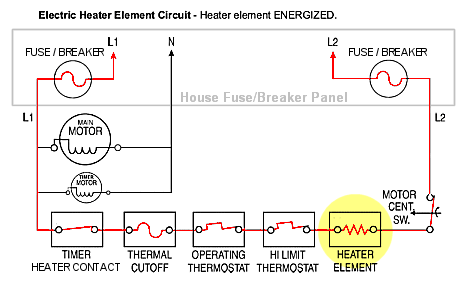
These can include the heat selector switch mounted on the console panel, one of the thermostats (from 2 to 5 on some models) mounted in various locations of the internal dryer ducting, the motor switch or the heater contacts of the timer or a 'heater relay' on newer models with an electronic heat control mechanism.
A link below explains dryer thermostat's operation in detail.
- A burnt wire or wire connector.
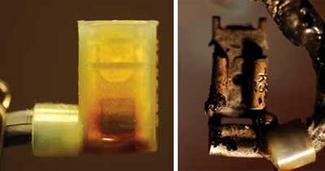
Replace the burnt wire connector and/or wire and inspect the component terminal it was attached to. If any sign of charring or discoloration are visible on the component's terminal or repeated failures occur at that same location, replace the component the terminal is part of. Such items can include the main power junction terminal block (very common), thermodiscs (thermostats), heat selector switch, centrifugal switch (on the motor) or the timer.
|
 |
How do I test for continuity?
How long can my dryer vent be?
Repair Parts : Showcase : Dryer Thermostats
*Thermal fuse locations on some Whirlpool, KitchenAid and Kenmore dryers
*Thermal fuse location on some Norge, Magic Chef and Maytag dryers
*Thermal fuse location on some Frigidaire, White Westinghouse and Gibson dryers
*Thermal fuse location on some newer GE and Hotpoint dryers
Using crimp-on connectors
|
 |
* If any of the thermal safeties have failed, thoroughly check the whole dryer exhaust all the way to the outdoors! They are the first line of defense to try to prevent a dryer fire caused by poor venting.
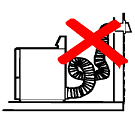
How long can my dryer vent be?
|
|


